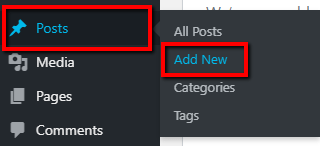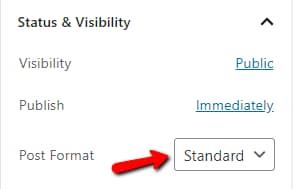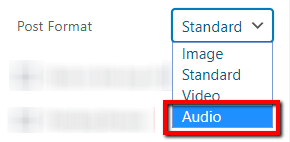Adding an “Audio Post” in your WordPress dashboard is very easy, especially if you use a Thrive Theme Builder Theme. Here is how to do this:
Add a new Audio Post
In your WordPress admin dashboard, hover over the “Posts” item from the left side menu and click on “Add New” from the sub-menu that appeared:

You will see the “Post Format” option in the right side of the editor. Click on the field with the current format:

This will open the list with the available “Post Formats”, select “Audio” from it:

Choose the Audio Format Type
Then, you’ll see a few additional “Thrive Audio Post Format Options” appear below the editor:

There are three “Thrive Audio Post Format Options” you can choose from:
Custom
The”Custom” option is selected by default. You can use this option to upload custom audio and then customize it a little:

There are two ways in which you can upload the file.
1. If you want to upload the audio file using its URL, then simply paste the URL in the designated field with the “Add an audio URL from the Media tab, or upload an audio.” instruction text.
2. In order to upload a file, click on the “Upload Audio” button. This will open the Media Library where you can select the file (if you have previously uploaded it), or use the “Upload Files” option, to upload it first and then, select and insert it.
The file or target URL has to be an audio file format such as .mp3, .wav, .ogg or .wma. We recommend using the .mp3 format.
3. Once the audio file is uploaded, you can check the checkbox for the options below it if you want to use them:
-
Checking the “Autoplay” option will mean that the file will start to play automatically when someone opens your post
-
Checking the “Loop” option will mean that the audio file will be on a loop, which means that it will play over and over again until it is stopped.
-
Checking the “Allow Users to Download” option will mean that the users will have the possibility of downloading the files on their computers.
SoundCloud Audio
With the SoundCloud option, you can add a SoundCloud audio file as your new post, and customize it as well. In order to do that first select the “Soundcloud” option from the “Thrive Audio Post Format Options”. Then you will see the SoundCloud options appear:

1. Enter the URL of the SoundCloud audio you want to display as the post in the designated field. It needs to be the URL to a single track or a playlist on SoundCloud (e.g. https://soundcloud.com/elliegoulding/ellie-goulding-beating-heart-vindata-remix).
2. Then, if you want to use the customizing options, you can check the checkbox next to them, below the SoundCloud URL field:
-
Autoplay – checking this will mean that the SoundCloud audio will start playing automatically when someone will open the post.
-
Hide artwork – if you check this option, the artwork, meaning the image associated with the SoundCloud audio will not be displayed.
-
Hide user – checking this option will mean that the user (the author/artist) of the respective SoundCloud audio file will not be shown.
Spotify
If you want to upload an audio file from Spotify, then select the “Spotify” option from the “Thrive Audio Post Format Options”. Then simply add the Spotify audio URL in the designated field that appears:

Save Draft or Publish
After you have added the audio file (regardless of which “Thrive Audio Post Format Option” you have used), make sure you also add a title to the post, and then you can:
-
either save it as a draft, using the “Save Draft” button from the upper right corner of the editor and continue working on the newly added post
-
or publish it, using the “Publish” button, from the upper right corner of the editor:

This is how easily you can add “Audio Posts” with Thrive Theme options in your WordPress admin dashboard. If you want to find out about other Thrive features and options, don’t forget to check out our knowledge base.
Note: If you’re using Thrive Theme Builder, you can also customize the audio when editing an Audio Post Template, as well as switch to Thrive Architect and customize the “Audio” element from there.
Please take a look at this article, if you need more information about how to do that.
Hopefully, this article was useful for you. If so, please give it a smile below 🙂